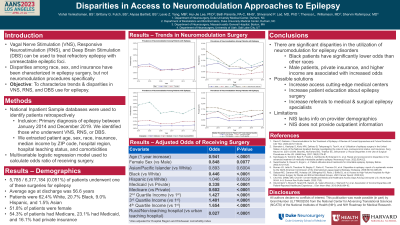Disparities in Access to Neuromodulation Approaches to Epilepsy
Friday, April 21, 2023


Vishal Venkatraman, BS (he/him/his)
Medical Student
Duke University
Durham, North Carolina, United States
ePoster Presenter(s)
Introduction: Epilepsy affects 1-2% of the global population, and those who are resistant to medical treatment frequently require neuromodulation. In selected populations, approaches including deep brain stimulation (DBS) and reactive neurostimulation (RNS) are used. While studies have shown that Black, Hispanic, poor, and rural patients have less access to epilepsy care and have lower rates of epilepsy surgery, disparities in the use of neuromodulation for epilepsy treatment are currently unknown.
Methods: We queried the National Inpatient Sample database from January 1, 2014, to December 31, 2019, for all discharges with an ICD-9 or ICD-10 diagnosis of epilepsy. Among these discharges, the rates of neuromodulation treatment, including DBS and RNS, were reported in each subgroup of race, ethnicity, and insurance. To generate national estimates, all analyses were weighted.
Results: A total of 6,529,499 discharges with epilepsy were identified, of which 5,870 (0.09%) received neuromodulation treatment for epilepsy. Black (n=505, 0.04%, OR=0.39, 95% confidence interval) Confidence Interval [CI] [0.31, 0.48]) patients were less likely to receive neurostimulation treatment than white (n=3,925, 0.1%) patients, whereas Hispanic (n=780, 0.13%, OR=1.36, 95% CI [1.1, 1.68]) patients were more likely to receive neuromodulation treatment. There was no significant difference between Asian (n=115, 0.12%, OR=1.24, 95% CI [0.8, 1.91]) and white patients, or between female (n=2,940, 0.09%, OR=0.95, 95% CI [0.84, 1.07]) and male (n=2,930, 0.09%) patients. Patients with Medicare (n=1,415, 0.04%, OR=0.15, 95% CI [0.13, 0.17]), Medicaid (n=1,330, 0.09%, OR=0.32, 95% CI [0.27, 0.38]), or no insurance (n=55, 0.02%, OR=0.09, 95% CI [0.04, 0.17]) were less likely to receive neuromodulation treatment than those with private insurance (n=2,840, 0.27%).
Conclusion : We discovered significant disparities in the use of neuromodulation treatments for epilepsy based on race and insurance status. More research will be required to determine the cause of these disparities.
Methods: We queried the National Inpatient Sample database from January 1, 2014, to December 31, 2019, for all discharges with an ICD-9 or ICD-10 diagnosis of epilepsy. Among these discharges, the rates of neuromodulation treatment, including DBS and RNS, were reported in each subgroup of race, ethnicity, and insurance. To generate national estimates, all analyses were weighted.
Results: A total of 6,529,499 discharges with epilepsy were identified, of which 5,870 (0.09%) received neuromodulation treatment for epilepsy. Black (n=505, 0.04%, OR=0.39, 95% confidence interval) Confidence Interval [CI] [0.31, 0.48]) patients were less likely to receive neurostimulation treatment than white (n=3,925, 0.1%) patients, whereas Hispanic (n=780, 0.13%, OR=1.36, 95% CI [1.1, 1.68]) patients were more likely to receive neuromodulation treatment. There was no significant difference between Asian (n=115, 0.12%, OR=1.24, 95% CI [0.8, 1.91]) and white patients, or between female (n=2,940, 0.09%, OR=0.95, 95% CI [0.84, 1.07]) and male (n=2,930, 0.09%) patients. Patients with Medicare (n=1,415, 0.04%, OR=0.15, 95% CI [0.13, 0.17]), Medicaid (n=1,330, 0.09%, OR=0.32, 95% CI [0.27, 0.38]), or no insurance (n=55, 0.02%, OR=0.09, 95% CI [0.04, 0.17]) were less likely to receive neuromodulation treatment than those with private insurance (n=2,840, 0.27%).
Conclusion : We discovered significant disparities in the use of neuromodulation treatments for epilepsy based on race and insurance status. More research will be required to determine the cause of these disparities.
